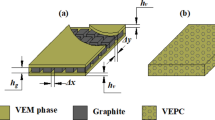Abstract
Experimental study on scheme optimization of composite damping structure was carried out and the effect of environmental temperature on damping characteristic was investigated in the present study. Damping coefficient of three layers composite damping structure is nearly ten times of that of light plate. The scheme of composite damping structure has a significant effect on damping characteristic. Effect of environmental temperature on damping characteristic was analyzed under temperature range from −10 °C to 80 °C. It shows that both of frequency and damping coefficient of composite damping structure are influenced by environmental temperature. There is a minimum frequency value which occurs at nearly 30 °C in the temperature range. Damping coefficient decreases with the increase of environmental temperature. The maximum damping coefficient is more than twice of the minimum one. Environmental temperature needs to be well considered in the practical application of composite damping structure.









Similar content being viewed by others
References
Xue Y, Yuansheng W, Jinhua Z, Hongwei Y (2005) Damping properties of the composite structures with multilayered damping materials. Acta Mat Com Sic 22(3):175–181
Jean MB (2006) Damping analysis of laminated beams and plates using the Ritz method. Compos Struct 74:186–201
Yadollahpour M, Kadkhodapour J, Ziaei-Rad S, Karimzadeh F (2009) An experimental and numerical investigation on damping capacity of nanocomposite. Mater Sci Eng A 507:149–154
Lee JH, Kim J (2001) Development and validation of a new experimental method to identify damping matrices of a dynamic system. J Sound Vib 246(3):505–524
Barbieri N, Novak PR, Barbieri R (2004) Experimental identification of damping. Int J Solids Struct 41(13):3585–3594
Ivancic F, Palazotto A (2005) Experimental considerations for determining the damping coefficients of hard coatings. J Aerosp Eng 18(1):8–17
Filipe M, Alvaro C, Elsa C et al (2010) Damping estimation using free decays and ambient vibration tests. Mech Syst Signal Process 24(5):1274–1290
Hui L, Wei S, Yongfeng Z, Qingkai H (2013) Comparative study on testing methods for damping property of cantilever thin-plate structure. Chin J Constr Mach 11(4):347–353
Ruzzene M (2000) Finite element modeling of magnetic constrained layering damping. Journal of Sound and Vibration 236(657):682
Yinming S, Hongxing H, Hugo S (2004) The finite element analysis and experimental study of beams with constrained layering damping treatments. J Sound Vib 278:343–363
Zheng H, Cai C, Pau GS et al (2005) Minimizing vibration response of cylindrical shells through layout optimization of passive constrained layer damping treatments. J Sound Vib 279:739–756
Lumsdaine A, Scott RA (1998) Shape optimization of unconstrained viscoelastic layers using continuum finite elements. J Sound Vib 216(1):29–52
Haochuan W, Ling Z, Linong L (2012) Thickness optimization study of constrained damping plate. Appl Mech Mater 226:436–439
Pan L, Ling Z, Zhanpeng F (2014) Topology optimization of constrained layer damping structure based on SIMP interpolation method. Mech Sci Tech Aero Eng 33(8):1122–1126
Young KL, Tae JH, Joong HJ, Chong SC (2004) Effect of thermal ε martensite content and deformation on damping capacity of a co-32 wt.% Ni alloy. Mater Sci Eng A 370:468–472
Hou JF, Bai HB, Li DW (2008) Damping capacity measurement of elastic porous wire-mesh material in wide temperature range. J Mater Process Technol 206:412–418
Zhou Y, Fan G, Xue D et al (2009) High damping capacity in a wide ambient-temperature range in hydrogen-doped and hydrogen-free Ti-45Pd-5Cr martensitic alloy. Scr Mater 61:805–808
Yuqin J, Yuhua W, Ning L et al (2009) Effect of environmental temperature on damping capacity of cu-Al-Mn alloy. Trans Nonferrous Metals Soc China 19:616–619
Acknowledgements
This study is supported by the National Nature Science Foundation of China (No.51371146).
Author information
Authors and Affiliations
Corresponding author
Additional information
Publisher’s Note
Springer Nature remains neutral with regard to jurisdictional claims in published maps and institutional affiliations.
Rights and permissions
About this article
Cite this article
Huo, S., Yuan, Z., Ren, J. et al. Experimental Study on Scheme Optimization of Composite Damping Structure. Exp Tech 44, 349–353 (2020). https://doi.org/10.1007/s40799-020-00364-x
Received:
Accepted:
Published:
Issue Date:
DOI: https://doi.org/10.1007/s40799-020-00364-x




